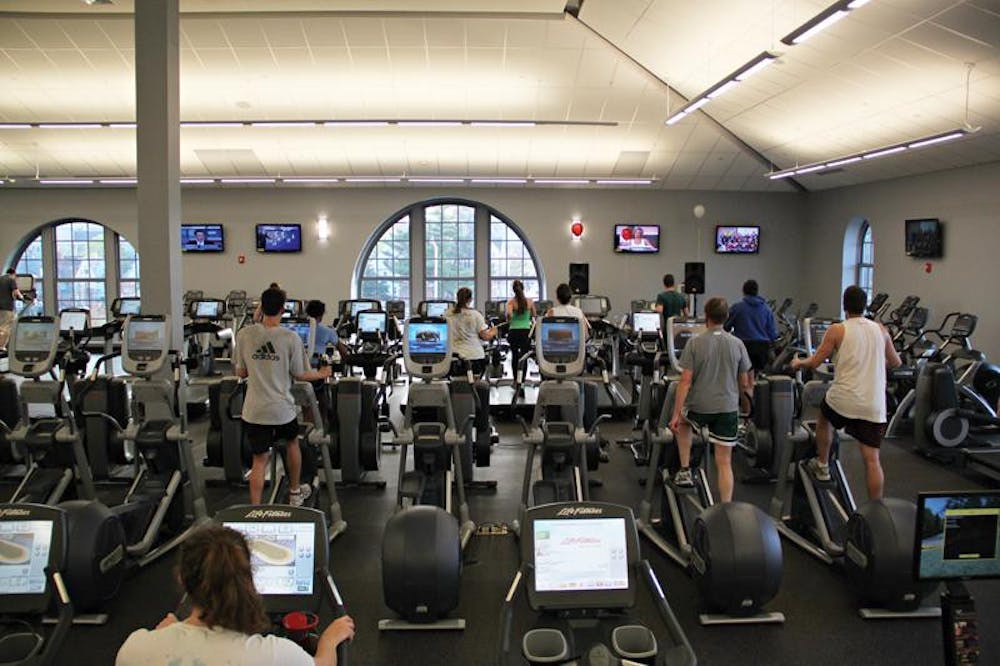Following recommendations made by former president Ruth Simmons last October, the University is in the process of implementing far-reaching changes within the athletics department, including a reduction in admission spots for recruited athletes, an increase in coaches' salaries and new fundraising efforts for improving athletic facilities.
Reducing admission spots
The University's reduction of recruitment admission spots from 225 to 205, a decrease of 9 percent, will take three years to implement and will begin this year, according to the Admission Office.
It is too early to speculate on the impact of these changes since this will be the first admission cycle the reduction will be in place, said Jack Hayes, director of athletics.
"We came up with a plan for how to do it while not disproportionately disadvantaging any of the teams," said Provost Mark Schlissel P'15, adding the admission changes would be made gradually so no team would be affected all at once.
Administrators will take away no more than one or two spots per team, Schlissel said. The decision will be based partly on how each team fares competitively as well as how many spots are allotted at other Ivy League institutions.
The changes in funding and admission resulted from an often-heated debate over the University's athletic programs beginning in 2011. The Athletics Review Committee, which was formed to examine possible athletic reforms, submitted a report to Simmons in May 2011 citing the budgetary difficulties of sustaining the University's 37 varsity teams. The committee recommended eliminating four varsity teams - the men's and women's fencing teams, the ski team and the wrestling team - in a move that sparked backlash from coaches, team members and alums.
In her subsequent recommendations to the Corporation one year ago, Simmons did not recommend going through with the proposed team cuts, instead endorsing new fundraising for facilities upgrades and for raising coaches' salaries, which had been below the Ivy League average. In April 2011, The Herald reported that Brown head coaches earned an average of $63,618 a year compared to a league-wide average of $81,788. The Corporation adopted Simmons' recommendations at its October 2011 meeting.
Salary increases
The University's decision to create a $1 million pool for raising coaches' salaries has been met with widespread approval from coaches.
"The pay increase is a positive effect," said David Amato, head coach of the wrestling team. Michael LeBlanc, head coach of the ski team, said he already works two other jobs in addition to coaching and that he hoped the pay raise would allow him to devote more time to the team.
Amato and LeBlanc both expressed optimism for the future of their teams, which had been on the brink of elimination during last year's review.
"I think we weathered the storm last year," Amato said, adding that he was pleased with the fundraising efforts of wrestling team alums who also lobbied the University to keep the team's varsity status. "What happened maybe even strengthened the program as far as alumni stepping up to the plate."
Hayes said that, to the best of his knowledge, funding from the University has not changed for the four teams that had been under review. "They're on a stable path moving forward and doing everything that every other team is," he said. He added that he has met with alums from each of the four teams who expressed excitement about the future of the programs now that the University has committed to them.
The Corporation's review also mandated that the ski team change its practice location to both make it more accessible and cut travel costs. In their report to Simmons, members of the Athletics Review Committee had expressed concern about safety issues related to the frequent long-distance travel to New Hampshire and Massachusetts for practices and events.
The athletics department has not finalized the ski team's new practice location, Hayes said, but all of the spots under review are closer to campus than previous locations. He said a final decision on the team's permanent practice location will likely come within the next couple months.
"We were already compliant with what (the Athletics Review Committee) was demanding," LeBlanc said. He said he works around ski team members' schedules and that the team now holds most of its practices at Blue Hills, Mass.
Facilities upgrade
Another key budgetary change from the Corporation's review of athletics was the creation of a new $42 million endowment for funding facilities upgrades and other long-term enhancements for athletic programs. The University has already taken out a loan to pay for the first $6 million in facilities upgrades, including the new field hockey field and the renovated gym, Schlissel said. Administrators are contacting alums and parents to raise funding to finance the $6 million loan and meet the $42 million endowment goal, he said.
"We're working on reaching out to them and telling them how increased funding benefits athletic programs," Schlissel said, adding that the interest earned on the new endowment will go toward a host of long-term upgrades for athletics. He declined to say how much had already been raised but said administrators were "very optimistic" about reaching their fundraising goal.
"Our early efforts have been very positive," Hayes said. He singled out new locker room construction and renovations to the softball field as already apparent evidence of the benefits yielded by increased funding.
President Christina Paxson has stated her intent to initiate a capital campaign, but Schlissel said the commitment to create the $42 million endowment for athletics would continue regardless of whether it is eventually incorporated into the new plan.
The University's efforts to grow funding for athletics and to improve facilities have been a welcome change for many athletes.
"The new facilities are fantastic," said Nathan Elder '13, a member of the men's track team. Elder said while he initially felt it was strange the University had increased funding for facilities upgrades while also reducing admission spots, he decided the reforms could work. "If decreasing the number of spots increases the prestige of Brown, then for me, I'd rather have a smaller number of really good athletes than a large number of mediocre ones."
Athlete reactions
But some athletes said the University's reduction in admission spots could harm recruiting efforts. "I don't know if they went about cutting spots in the right way," said Cory Abbe '13, captain of the women's fencing team. Abbe said if there is a future increase in the number of athletes interested in applying to the University, the reduction in spots would complicate recruiting efforts.
"It's definitely going to be harder to be able to look at as many recruits," said Emma LeBlanc '14, co-captain of the ski team, adding that the reduction in spots would give coaches less "security" because they would have fewer spots to offer sought-after recruits.
"I definitely disagree with the decision to cut admission spots," said Augu
stus Marker '16, a member of the wrestling team. "Giving athletes the opportunity to compete in the Ivy League definitely helps the league's reputation." Echoing other athletes, Marker added that he definitely would have explored alternatives to Brown if he had been applying after the reduction in admission spots.
"It's really hard to get in touch with coaches and hear they only might have a spot," said Katie Liebowitz '16, a member of the ski team. "I think it's going to make the decision-making for the applying athletes tougher."
Though many athletes that had been under review opposed the reduction in admission spots, others said they felt their teams were now on a sustainable path toward the future.
"It was very clear to the public that Brown decided to save these teams and decided to apply more resources to athletics," Abbe said, adding she would be interested to see how the University reconciles its reduction in admission spots for recruits with the simultaneous increase in athletics funding.
Katie Deutsch '13, a member of the fencing team, said the team's lobbying efforts to save itself from elimination last year improved its visibility. "Because we've raised all this money, we've shown people care about fencing," she said.
Deutsch noted that while some members of the team remain unhappy about how close they came to losing their varsity status, the team is in a great position now.
"There's probably a little lingering resentment, but it's not getting in the way," she said.

ADVERTISEMENT




